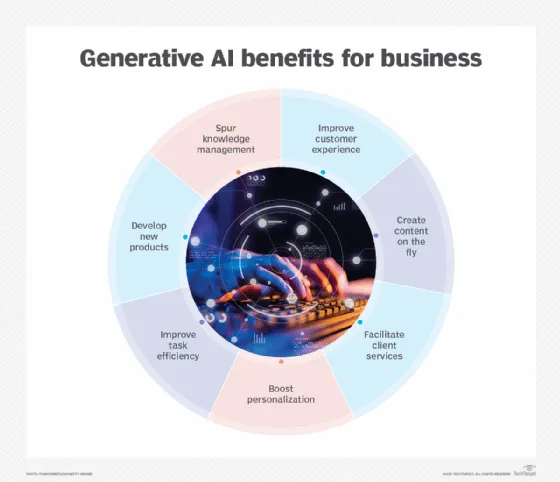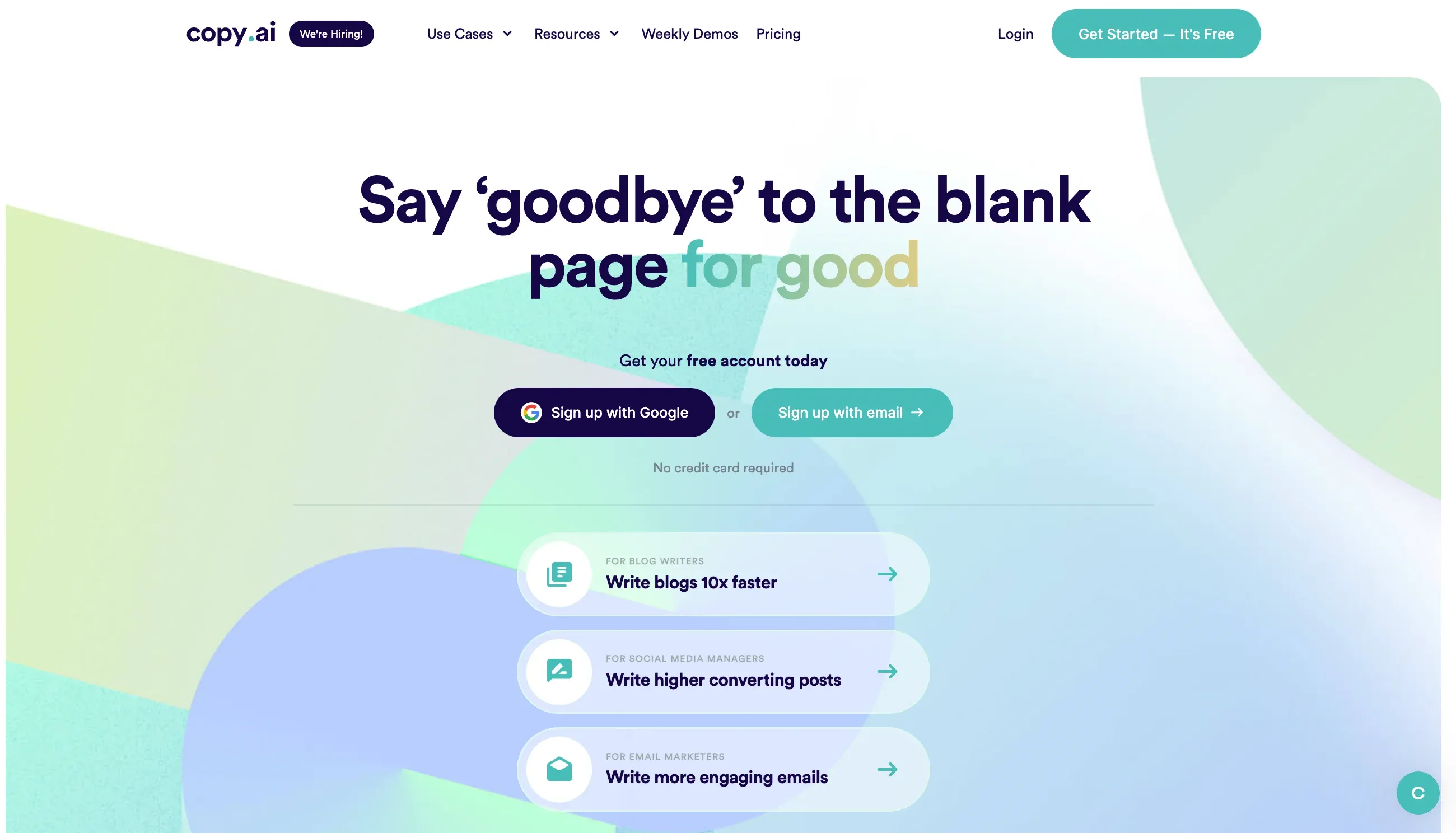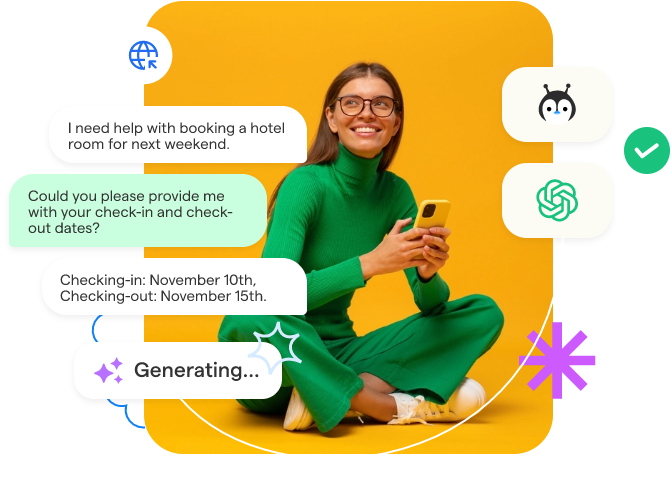What if an artificial assistant could do your repetitive work so you have more time for creative thinking? Well, with generative AI apps, this is becoming a reality.
Generative AI can write texts, generate images, design graphics, and more without human involvement.
Powered by advanced machine learning algorithms, these new "self-writing" programs are learning to be helpful digital helpers who take mundane tasks off our plates.
The best part? Generative AI apps are customizable.
They get to know your preferences and ways of working to provide personalized recommendations and support.
Whether it's streamlining decisions for businesses or developing technologies to assist people with disabilities, generative AI is augmenting human abilities in exciting new ways.
Curious to learn how these innovative programs could benefit you? In this blog post, we'll explore 9 amazing ways generative AI apps reshape how we work and unlock our creative potential.
Learn how generative AI could help you work smarter and accomplish more!

1. Improve productivity and efficiency
Generative AI apps can create new things independently and help us get more work done faster and easier. They take over repetitive tasks like data entry or writing content. This frees up people to focus on more challenging and more creative work.
This means people don't have to analyze everything by hand. They can also answer customer questions quickly without people needing to help each time. This makes work more efficient and customers happier.
Creative professionals like designers or marketers can also use these AI programs to speed up their creative process.
The Generative AI apps can help brainstorm ideas or make different design versions. They augment human creativity, which leads to more innovative thinking and greater productivity.
2. Enhance creativity and innovation

Generative AI apps benefits are not limited to automating tasks; they can also serve as catalysts for creativity and innovation.
By using advanced machine learning algorithms, these Generative AI apps help generate ideas and enhance problem-solving capabilities.
For instance, in art and design, generative AI apps can create unique visual outputs based on input parameters. Artists can experiment with different styles, colors, or compositions, inspiring new artistic directions.
These apps can generate and optimize complex structures in architecture and engineering, offering new possibilities for innovative designs. Moreover, generative AI apps facilitate Collaboration and knowledge sharing.
These apps can analyze and synthesize vast amounts of data, extracting patterns and insights that may not be immediately apparent to humans.
By presenting this information in a digestible format, generative AI apps empower individuals and teams to make informed decisions and fuel further Innovation.
3. Personalization and customization
Generative AI apps are masters at providing personalized experiences and customization options.
By analyzing user preferences, behavior, and feedback, these apps can tailor recommendations and suggestions to individual needs.
In the field of e-commerce, generative AI apps offer personalized product recommendations based on browsing history or purchase patterns. This enhances the customer experience by showcasing relevant and appealing items, ultimately driving sales.
Furthermore, generative AI apps benefit by enabling customization in various domains. In fashion, these apps can generate unique designs based on customer preferences, resulting in made-to-order garments.
In the healthcare sector, these apps can create personalized treatment plans or assistive devices for patients, optimizing their care.
By using the power of personalization, generative AI apps create a more engaging and relevant user experience. They empower individuals to shape their interactions with technology and receive tailored solutions that align with their unique requirements.
4. Streamline Decision-Making Processes
Generative AI apps can streamline decision-making processes by providing valuable insights and recommendations.
These apps can analyze vast amounts of data quickly and accurately, presenting the most relevant information clearly. They can also simulate complex scenarios, giving decision-makers a glimpse of how different options may play out.
For instance, a generative AI app like KAI can assist companies in the banking sector. KAI is a Conversational AI platform that can analyze data to provide predictive insights.
It can help financial institutions streamline their internal decision-making processes, improve customer service, or provide financial advice to customers.
KAI can also automate customer interactions, offering a chatbot to assist customers with their Banking needs.
Generative AI apps benefits your businesses by helping them make more informed decisions in less time. This enhances organizational agility and flexibility, allowing companies to adapt to changing market conditions and stay ahead of the curve.
Suggested Reading:
5. Improve Customer Service and Support

Generative AI apps can help companies improve customer service and support by automating some of the most common customer inquiries and complaints.
These apps can respond quickly and accurately to frequently asked questions, freeing customer service representatives to tackle more complex issues.
For instance, an app like Ada can automate customer interactions through chatbots. It can understand customer queries and provide relevant information or assistance.
Ada can also recognize when a query requires the attention of a human representative, and it can transfer the conversation accordingly.
Companies can use generative AI apps like Ada to enhance customer satisfaction, reduce response times, and provide accurate information.
These apps can also handle high volumes of customer inquiries, ensuring no customer is on time for a response.
Another example of Generative AI in customer service is chatbot! With the advent of Natural Language Processing and generative AI, chatbots have become capable of generating responses that are similar to humans. And that is where BotPenguin steps in.
With advanced AI capabilities and native integration with ChatGPT, BotPenguin allows users to create a no-code AI chatbot that can conversate like humans for various platforms like:

6. Data Analysis and Pattern Recognition
These generative AI apps are very good at analyzing large amounts of data and finding patterns. They can do this kind of advanced analysis at a scale that would be impossible for people to do by hand.
Using machine learning algorithms, these apps can identify correlations and patterns in data sets that would take humans much time and effort to recognize.
For example, a generative AI app like IBM Watson can analyze large volumes of unstructured data to derive insights for businesses in various industries.
Watson can analyze data to identify patterns in customer behavior, help HR with talent acquisition, or even assist doctors in diagnosing medical conditions.
By using generative AI apps for data analysis and pattern recognition, businesses can gain valuable insights into operational efficiency, revenue growth, and even improved customer service.
These apps can also help detect fraud and security breaches, protecting sensitive information from malicious actors.
7. Assistive Technology and Accessibility
Generative AI apps are essential in enhancing accessibility and providing assistive technology solutions for individuals with disabilities.
These apps can automate tasks and support individuals facing challenges accessing information or performing certain activities.
For example, a generative AI app like Seeing AI can assist people with visual impairments. It uses advanced computer vision algorithms to recognize and describe the surrounding environment to the user.
This app can read text, identify objects, and recognize people's facial expressions, enabling greater independence and accessibility for individuals with visual impairments.
Using generative AI apps, we can help create a more inclusive society where people of all abilities have equal access to information and opportunities.
Suggested Reading:
8. Automate Repetitive and Mundane Tasks
Generative AI apps are designed to automate repetitive and mundane tasks, freeing up valuable time for individuals and businesses.
These apps can handle tasks that are monotonous and time-consuming and do not require human creativity or critical thinking.
For instance, a generative AI app like Zapier can automate workflows by connecting different apps and services.
It can perform tasks such as data entry, file management, and email automation, eliminating the need for manual intervention.
Using generative AI apps for task automation, businesses can increase efficiency, reduce human error, and allocate human resources to more complex and valuable activities.
Individuals can also benefit from the time saved, allowing them to focus on tasks requiring unique skills and expertise.
9. Improve Accuracy and Reduce Errors
Generative AI apps are designed to improve accuracy and reduce errors in various tasks.
Using machine learning algorithms, these apps can analyze vast amounts of data with precision and consistency, minimizing the risk of human error.
For example, a generative AI app like Grammarly can analyze written content and suggest corrections for grammar, spelling, and punctuation errors.
It can also offer suggestions to improve clarity and style, ensuring that written communication is accurate and effective.
By using generative AI apps, businesses can minimize costly errors in data analysis, reporting, and communication.
This leads to better decision-making, improved customer satisfaction, and enhanced productivity. Individuals can also benefit from the accuracy and reliability of generative AI apps in their personal and professional tasks, ensuring high-quality outputs.
Now, let us see some of the Generative AI Apps Use Cases.
Conclusion
Generative AI is transforming how we live and work.
From automating mundane tasks to powering assistive technologies, these self-writing programs remarkably augment human capabilities.
The possibilities are endless when we apply generative AI to improve productivity, enhance decision-making, and foster innovation.
If you're ready to start benefiting from this emerging technology, BotPenguin is the solution.
BotPenguin's chatbots are advanced natural language processing that deeply understands conversations. BotPenguin chatbots can interpret questions, determine what a user needs, and respond appropriately by analyzing sentence structure, intent, and context.
BotPenguin chatbots further leverage generative AI to facilitate more natural, productive dialogues. Instead of pre-scripted responses, the chatbots can generate original answers adapted to the user and chat history.
This provides more personalized, helpful conversations that meet each customer's individual needs.
Additionally, BotPenguin chatbots continually improve through machine learning. With every conversation, the AI models the human language patterns and updates its training. This allows the chatbot responses to become more accurate and relevant over time.
By harnessing multi-layered AI capabilities including NLP, and generative models, BotPenguin enables enterprise-grade chatbots that feel like conversing with a knowledgeable human expert specialized in your business domain.
Suggested Reading:
Frequently Asked Questions (FAQs)
What are the key benefits of generative AI?
Generative AI benefits offer diverse advantages, like enhanced creativity, streamlined automation, personalized content creation, and accelerated innovation. It enables efficient data analysis, aids in design and art generation, and revolutionizes content production across various industries.
Which industry benefits most from generative AI?
Generative AI benefits in Industries like healthcare, design, entertainment, and marketing notably benefit from generative AI. Healthcare utilizes it for diagnostics, while design and entertainment leverage it for creativity. Marketing relies on personalized content generation, showcasing the technology's versatility.
How will generative AI impact our lives?
Generative AI is set to transform daily life by optimizing tasks, automating processes, and fostering innovation. From customized experiences to improved decision-making, it will streamline various aspects, impacting everything from how we work to how we entertain ourselves.
Can Gen AI replace humans?
Generative AI augments human capabilities rather than replacing them entirely. While it excels in automating repetitive tasks and aiding in complex processes, the unique human touch, creativity, and nuanced decision-making remain irreplaceable in many spheres.

